Updated July 28, 2023
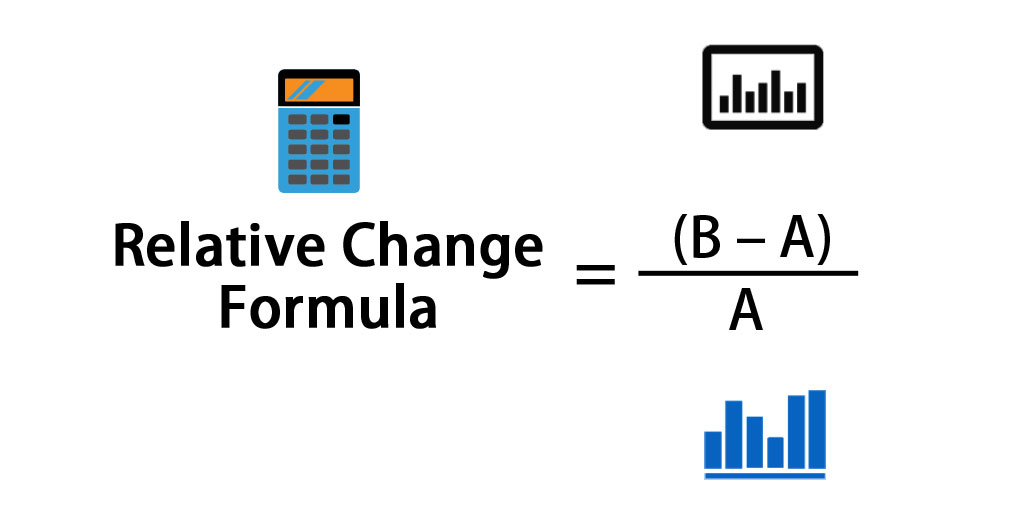
Relative Change Formula (Table of Contents)
- Relative Change Formula
- Examples of Relative Change Formula (With Excel Template)
- Relative Change Formula Calculator
Relative Change Formula
Relative numbers, as its name suggests, are the value related to other values and dependent on each other. In contrast, absolute values are independent of each other. So the term relative change is used to compare two variables taking into account their absolute value.
This comparison is generally expressed as the ratio, which is called relative percentage difference, and this number does not have any units. Absolute change normally will not tell you much about the variables, and to get more information, we need to use relative change.
For example: If we have two sets of numbers containing 2 variables each i.e. {2,5} and {104,107}. If you see here, the absolute change will be 5-2 and 107-104. Both have the same absolute change, and we can extract no other information from absolute change. But if we keep 2 and 104 as reference points, then the relative change will be 3/2 and 3/104. Although the absolute difference is the same, the relative difference is not the same and has a huge difference.
As I explained above, we typically express the relative change in percentage terms and refer to a specific value as a reference point. So the formula for relative change is :
Where
- A – 1st Variable (Reference)
- B – 2nd Variable
Examples of Relative Change Formula (With Excel Template)
Let’s take an example to understand the calculation of Relative Change in a better manner.
Relative Change Formula – Example #1
Let’s say you have invested a sum of $10,000 in a Bank, and next year the value of your investment increased to $11,000. You want to see the absolute and relative change in the value of your investment.

Solution:
The formula to calculate Absolute Change is as below:
Absolute Change = B – A
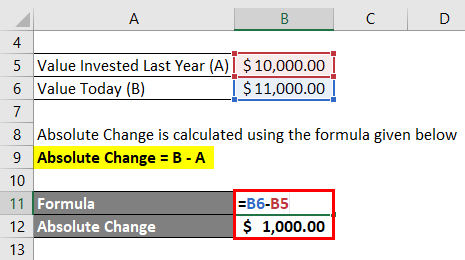
- Absolute Change = $11,000 – $10,000
- Absolute Change = $1,000
So in absolute terms, your investment has increased by $1,000.
The formula to calculate Relative Change is as below:
Relative Change = (B – A) / A
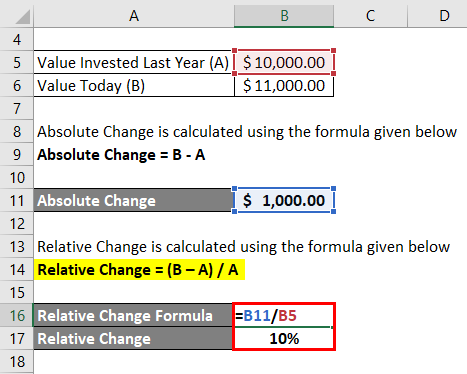
- Relative Change = $1,000 / $10,000
- Relative Change = 0.1 or 10%
So in relative terms, the value of an investment has been increasing by 10%.
Relative Change Formula – Example #2
Continuing the above example, let’s say you also invested another $5000 in another bank, which has increased to $6000 in a year. So, now you have 2 investments and want to see which has given more return.
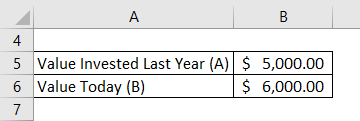
Solution:
The formula to calculate Absolute Change is as below:
Absolute Change = B – A
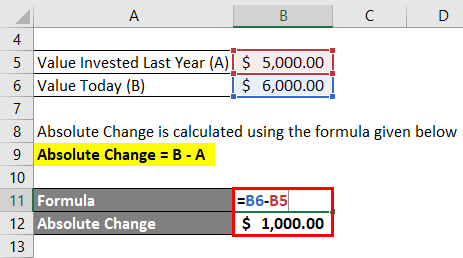
- Absolute Change = $6,000 – $5,000
- Absolute Change = $1,000
So in absolute terms, your investment has increased by $1,000.
The formula to calculate Relative Change is as below:
Relative Change = (B – A) / A
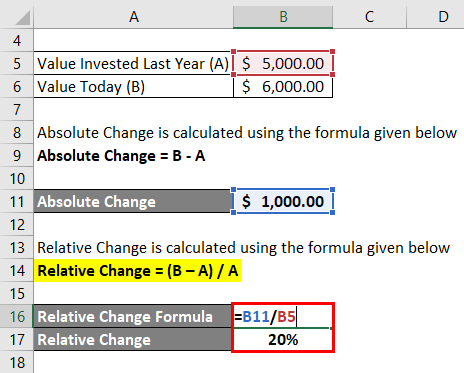
- Relative Change = $1,000/$5,000
- Relative Change = 0.2 or 20%
So if you see here, although both the investments have given the same returns in absolute terms, Investment 2 is better regarding the relative change. This is because the reference point of both investments is not the same. In investment 1, we earned 1,000 on 10,000, but in investment 2, the same amount we earned in 1,000. So 2 is better.
Explanation
As explained above, Relative Change is the comparison of two variables and helps us analyze the change of one variable with respect to others. We can use the below-mentioned steps to use the relative change concept effectively:
- The first step is to determine the absolute change between the numbers we want to compare. So we need to take a difference between the two variables we have.
- Secondly, we need to set the reference point because that will help us determine the relative change. Remember that the reference value cannot be zero, and we cannot calculate a relative change of that since it is not defined.
- Once we have selected the reference value, we take the absolute difference and divide it by the reference value to calculate the relative change. So if the values are greater than a reference value, the relative change will be positive, and if the values are smaller than a reference value, then the relative change will be negative.
Relevance and Uses
Although absolute change sets the foundation of relative change, it does not have practical use compared to relative change. The concept of relative change is widely used across various fields of study.
For example: In the stock market, the relative change is used to calculate the percentage change in stock price/return on different stocks and helps us to analyze which stock has performed well compared to others. Companies can use this concept to compare various line items in their financial statements and then can accordingly.
For example: Let’s say company X had revenue of $100 last year and $110 this year. Also cost last year was $80, which has been increased this year to $90. So if we use the relative change formula, revenue has increased by 10 / 100 = 10%, but cost has been increased by 10 / 80 = 12.5%. So this will impact the company’s profit, and they can dig deep and understand why the cost is increasing and can take corrective action to curb the cost. The best thing about this relative change concept is that since it is unitless, it is not bound and can be applied anywhere and everywhere. Be it commercial calculations, management decisions, or simply your day-to-day analysis. Relative change is used everywhere.
Relative Change Formula Calculator
You can use the following Relative Change Calculator
| B | |
| A | |
| Relative Change Formula | |
| Relative Change Formula = |
|
|
Recommended Articles
This has been a guide to Relative Change Formula. Here we discuss how to calculate Relative Change along with practical examples. We also provide a Relative Change calculator with a downloadable Excel template. You may also look at the following articles to learn more –


